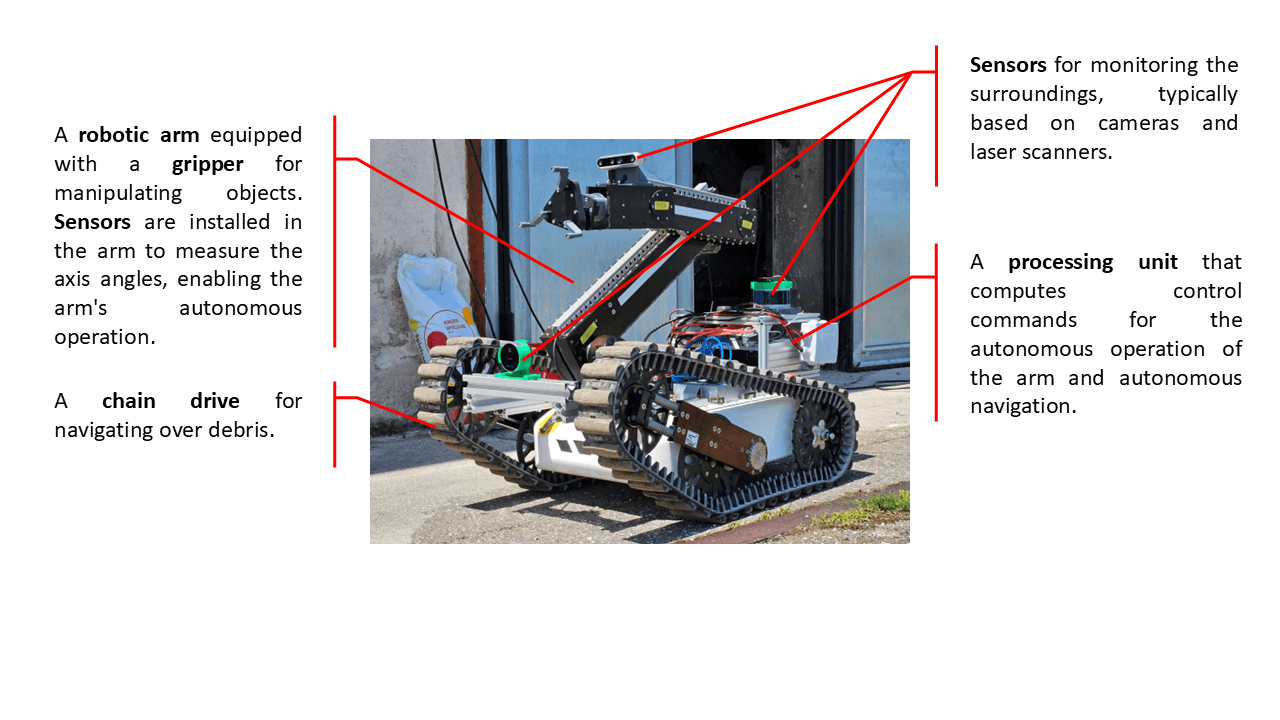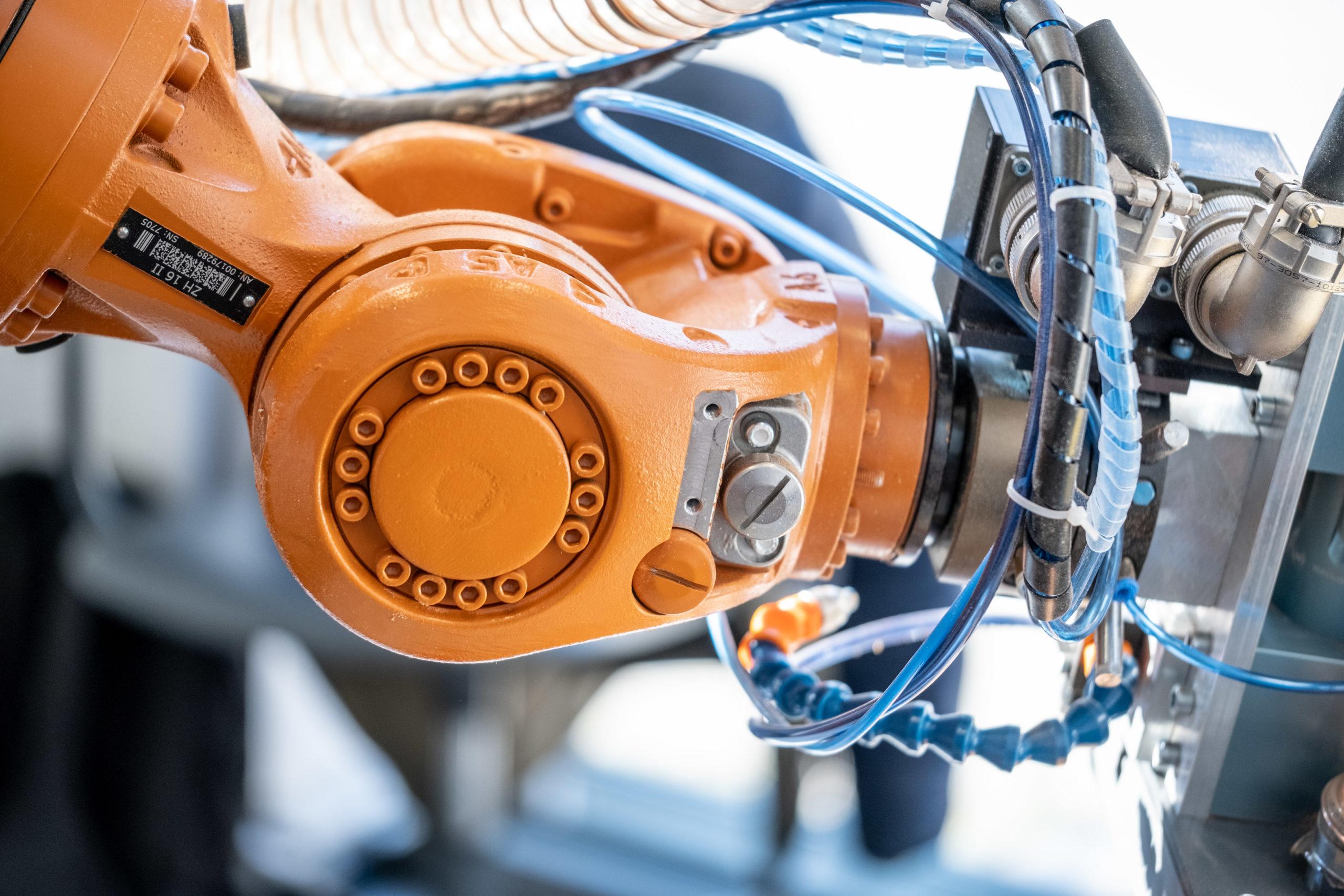Mechatronic systems and autonomous robots are no longer limited to the manufacturing industry. Technological advancements led to autonomous cars, vacuum robots, humanoid robots, and rescue robots. As an example of robots already in use, the following image shows a rescue robot developed in the research field Automation & Robotics, that autonomously searches for people in collapsed buildings and maps hazardous substances and nuclear radiation.

Such robotic systems will soon assist us in everyday life. These robots are considered a technological cornerstone to address the major challenges of the near future. Autonomous robot swarms on agricultural fields or adaptive robotic caregivers are already technologically feasible. Jet, these approaches must become reliable and easy to use. Hence, the current focus is on further developing these technologies and methods to be reliable, robust, and beneficial for society.
The research field Automation & Robotics focuses on the development and enhancement of methods, algorithms, and robots for automating processes. In addition to robotics, it incorporates adjacent technologies and scientific disciplines. Drawing on the expertise from the competence centers of the University of Applied Sciences Technikum Wien as well as completed R&D projects, the current focus is on the following topics:
- Manufacturing Industry: Digital production, interconnected machines, and virtual technologies for optimizing and automating production processes as well as production planning. This includes not only robotics and automation technology but also areas such as digital twins and AR/VR. Finally, traditional topics of mechanical engineering such as simulation (e.g. finite element analysis, CFD, multi-body and 1D simulation), measurement technology, or process engineering are addressed.
- Generative Manufacturing: Development of a multi-material manufacturing process with a focus on medical technology in order to be able to adjust properties of the manufactured parts according to requirements. Filament production by recycling plastics. Prototyping with different generative manufacturing methods.
- Service Robots: Robots as support systems for humans, encompassing everyday scenarios in households as well as rescue robotics.
To implement projects the aforementioned focus areas, the recent research emphasis draws on the expertise of scientists from the competence fields of all departments. Topics such as artificial intelligence and intelligent sensor technology are covered just as classical mechanical engineering or materials science.
While the focus of past projects was historically centered on industrial applications, current projects encompass a much broader spectrum, placing humans at the center of interest. With an emphasis on data-driven robotics, such as robotics powered by generative AI or machine learning-based robotic systems, the focus today is on robots designed to assist humans with complex tasks. Key areas of current research include robots’ perception (seeing, feeling, hearing) and autonomous decision-making based on data. The following completed projects are central to today’s research efforts:
- SAMY: Programming robots is repetitive and requires expert knowledge. This project developed an autonomous pipeline that enables non-experts to automate entire production facilities. SAMY was supported by the Austrian Research Promotion Agency as part of the 32nd call for Production of the Future.
- AIAV: A training platform for AI was developed for Viennese SMEs in this project. The focus was on linking hands-on examples with foundational concepts. Several use cases were implemented in the Technikum Wien Digital Factory as part of this project. AIAV (Project 26-04) was supported by MA23 – Economic Affairs, Labour and Statistics of the City of Vienna.
- UGV-ABC-Probe: In this project, an autonomous rescue robot (see image above) was developed. Using AI, a map of radioactive radiation was generated, allowing recruits of the Austrian Armed Forces to identify potential danger zones from a safe distance. UGV-ABC-Probe was supported by the Austrian Research Promotion Agency.
- InviS: This project establishes a competence team for the integration of virtual systems in teaching and laboratory exercises. InviS integrates virtual technologies into the academic activities of the UAS Technikum Wien. These technologies are considered as a key to managing the transition to the digitalization of industry and production. The results developed within InviS are therefore also used to create a course on the topic of virtual technologies in industrial applications. InviS (Project 29-11) was supported by MA23 – Economic Affairs, Labour, and Statistics of the City of Vienna.
- Lifomul3D: This project implemented the 3D-printing via projection-microstereolithography (PμSL) of materials based on lignin, the second-most abundant natural polymer and accumulating as byproduct of cellulose production. The goal is to print electrocardiography- (ECG) and electroencephalography- (EEG) compatible microneedle electrodes for long term monitoring applications in which the spatially controlled electric conductivity/insulation allows for superior signal quality and long-term stability. Through a novel approach to PµSl, sub-10 µm feature sizes and multi-material capabilities have been achieved. Lifomul3D is supported by the Austrian Research Promotion Agency.
Current research activities build upon these projects. The focus of ongoing research is on fully autonomous robotic systems across various applications and domains, with a particular emphasis on the manufacturing industry. Our vision is to provide autonomous robots to society that can be operated without requiring expert knowledge.

Head of Competence Center Digital Manufacturing, Automation & Robotics
Research Focus Manager Automation & Robotics
Senior Lecturer/Researcher
